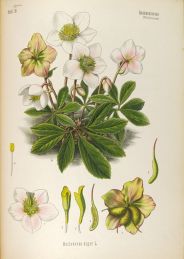Hellebore:
The Christmas Rose
By Audrey Stallsmith

At Christmas I no more desire a rose
Than wish a snow in May's new-fangled shows.
William Shakespeare, Love's Labor Lost
Black hellebore, also known as the Christmas Rose, seems a strange plant to associate with the happy and hopeful celebration of Christ's birth. It is, after all, one of the four classic poisons--along with nightshade, hemlock, and aconite. Attalus III, a nasty king of Pergamum, doted on hellebore since it "racked the nerves and caused the victim to swell."
But there was, we must remember, a paranoid and homicidal monarch in the Christmas story too. Perhaps hellebore's black and poisonous root can remind us of Herod, while its white, winter-blooming flowers bring to mind the innocents he murdered.
The "hell" in the plant's names seems to be inadvertent, though, since it derives from the Greek elein ("to injure") and hora ("food"). Hellebore is not actually a rose at all, but bears a slight resemblance to the single varieties. It was also known as melampode after a physician named Melampus who claimed to drive insanity out of his patients with it.
This seems to have been a commonly accepted use for the plant since Theodorus purged Gargantua "canonically with Anticyrian hellebore." The treatment purportedly "cleansed from his mind all perverse habits."
DeQuincey speaks of Walking Stewart, an eccentric British traveler, as being "crazy beyond the use of hellebore." And Pliny recommends the herb "to purge the brain in order to make it better for serious study." Many poisonous narcotics have a tranquilizing effect in small doses. I suspect hellebore did not so much cleanse minds as drug them into submission!
It was also supposed to purge disease from livestock. The sick animal wore a piece of the root in one pierced ear like the latest thing in organic jewelry.
Hellebore might "wipe out" annoying flies as well. Albertus Magnus whitewashed his walls with a mixture of lime, opium, and hellebore to repel insects. We can only hope that children weren't prone to eating paint chips back then.
The Christmas rose, Helleborus niger, is not the only member of its toxic family. Helleborus orientalis, also known as the Lenten Rose, blooms closer to Easter in an appropriate array of pastel colors. The less popular Helleborus foetidus is known for its stench--and green flowers.
According to superstition, any person harvesting hellebore roots should first draw a circle around the plant with a sword. Since most of us don't have such a blade handy these days, I would recommend leaving those roots in the ground. Hellebore is much too dangerous for use as an alternative medicine but, left undisturbed, it will bloom at a season when most of the garden is comatose.
Gerard reports that Helleborus niger "floureth about Christmas, if the weather be mild and warm." Keep in mind, though, that the British climate is more moderate than much of the United States. Here, the flowers might not emerge until March.
According to one tradition, Gabriel produced the out-of-season blooms for a sobbing shepherdess named Madelon, who had nothing to give the Christ Child. Those pristine flowers would certainly have been an appropriate gift for the cleansing "Rose e'er blooming" who came like "a floweret bright amid the cold of winter."
Helleborus niger image is fromNueste und Wichtigste Medizinalpflanzen in Naturgetreuen Abbildungen mit Kurzem,, courtesy of the Missouri Botanical Garden.








